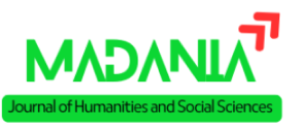Body Image in Teenage Women who Are Fans of K-POP Girl Bands: A Study on Students of IAIN Palangka Raya
DOI:
https://doi.org/10.59240/kjsk.v4i2.65Keywords:
Body Image, Korean Wave, K-Pop, Muslim StudentsAbstract
Korean culture has developed so rapidly that it has become widespread and accepted by the world public, resulting in a phenomenon of Korean culture fever at the global level, which can be referred to as the Korean Wave. This study aims to explore the understanding and experiences of female students at IAIN Palangka Raya who are fans of K-Pop girl groups in relation to body image. This qualitative research employs in-depth interviews, observations, and literature reviews with thematic analysis. The findings reveal diverse perceptions of body image and beauty standards, with the majority holding positive views. Factors influencing body image include media exposure, social comparison, social environmental pressures, as well as personality and self-esteem. Strategies used to manage pressures and expectations related to physical appearance include self-acceptance, personal development in other areas, seeking social support, and forming positive fan communities. This research highlights the significant role of social media and interactions within fan communities in shaping body image perceptions. The results provide new insights into the impact of popular culture on body image among adolescent girls and the strategies employed to cope with appearance-related pressures.
References
A.Rafiq. “Gereja Dan Pengaruh Teknologi Informasi ‘Digital Ecclesiology.’” Fidei: Jurnal Teologi Sistematika Dan Praktika 1, no. 2 (2019): 270–83. https://doi.org/10.34081/270033.
Alamin, Zumhur, and Randitha Missouri. “Penggunaan Media Sosial Sebagai Sarana Pendukung Pembelajaran Agama Islam Di Era Digital.” TAJDID: Jurnal Pemikiran Keislaman Dan Kemanusiaan 7, no. 1 (2023): 84–91. https://doi.org/10.52266/tadjid.v7i1.1769.
Alkalah, Cynthia. 済無No Title No Title No Title. Vol. 19, 2016.
Anggraeni, Azwa Salsabila, and Udi Rosida Hijrianti. “Peran Dukungan Sosial Dalam Menghadapi Fase Quarter Life Crisis Dewasa Awal Penyandang Disabilitas Fisik.” Cognicia 11, no. 1 (2023): 15–23. https://doi.org/10.22219/cognicia.v11i1.26176.
Anin, Anastasia F., BS Rasimin, and Nuryati Atamimi. “Hubungan Self Monitoring Dengan Impulsive Buying Terhadap Produk Fashion Pada Remaja.” Jurnal Psikologi 35, no. 2 (2008): 181–93. doi:https://doi.org/10.22146/jpsi.7951
BATORAN, SERLI, and NI WAYAN SUKMAWATI PUSPITADEWI. 2018. “PERBEDAAN KONSEP DIRI PADA MAHASISWA BERDASARKAN STATUS PARTISIPASI DALAM UNIT KEGIATAN MAHASISWA (UKM) UNIVERISTAS NEGERI SURABAYA”. Character Jurnal Penelitian Psikologi 5 (2). https://doi.org/10.26740/cjpp.v5i2.24852.
Bello, Bamidele M., Adesegun O. Fatusi, Oluwatomi E. Adepoju, Beatrice W. Maina, Caroline W. Kabiru, Marni Sommer, and Kristin Mmari. “Adolescent and Parental Reactions to Puberty in Nigeria and Kenya: A Cross-Cultural and Intergenerational Comparison.” Journal of Adolescent Health 61, no. 4 (2017): S35–41. https://doi.org/10.1016/j.jadohealth.2017.03.014.
Chang, Jungyoon. “New Gender Perspectives : Soft Creator and Strong Advocator in the New Korean Wave Era” 36, no. 4 (2020): 67–84. DOI: https://doi.org/10.14431/aw.2020.12.36.4.67
E. B., Gita Aprinta. “Strategi Cyber Public Relations Dalam Pembentukan Citra Institusi Pendidikan Tinggi Swasta.” Jurnal The Messenger 6, no. 1 (2016): 1. https://doi.org/10.26623/themessenger.v6i1.161.
Edward p.sarafino. HealthPsychology : Biopsychosocial Interactions, 2015. https://books.google.com/books?hl=en&lr=&id=ypODBgAAQBAJ&oi=fnd&pg=PR6&dq=Sarafino,+E.,+Smith,+T.+W.,+King,+D.,+%26+Delongis,+A.+(2015).HealthPsychology+:+Biopsychosocial+Interactions+-+Canadian+Edition.Amerika+Serikat:+John+Wiley+%26+Sons,+Inc.&ots=19lPj.
Fardouly, Jasmine, Brydie K. Willburger, and Lenny R. Vartanian. “Instagram Use and Young Women’s Body Image Concerns and Self-Objectification: Testing Mediational Pathways.” New Media and Society 20, no. 4 (2018): 1380–95. https://doi.org/10.1177/1461444817694499.
Fitriyani, Nur, Presetyo Budi Widodo, and Nailul Fauziah. “Hubungan Antara Konformitas Dengan Perilaku Konsumtif Pada Mahasiswa Di Genuk Indah Semarang.” Jurnal Psikologi Undip 12, (1) (2013): 55–68. https://doi.org/https://doi.org/10.14710/jpu.12.1.1-14.
Hadori, Mohamat. “AKTUALISASI-DIRI (SELF-ACTUALIZATION); SEBUAH MANIFESTASI PUNCAK POTENSI INDIVIDU BERKEPRIBADIAN SEHAT.” Jurnal Lisan Al-Hal 9, no. 2 (2015): 261–87. https://journal.ibrahimy.ac.id/index.php/lisanalhal/article/view/92/79.
Hanandha, Teresna Sainseillah, and Afif Kurniawan. “Hubungan Antara Body Image Dengan Self-Presentation Di Media Sosial Instagram Pada Remaja Putri.” Buletin Riset Psikologi Dan Kesehatan Mental 10, no. 212 (2023): 1–10. https://repository.unair.ac.id/119577/.
Hasrin, Awaluddin, and Sangputri Sidik. “Tren Kecantikan Dan Identitas Sosial: Analisis Konsumsi Kosmetik Dan Objektifikasi Diri Di Kalangan Perempuan Kota Palopo.” Jurnal Analisa Sosiologi 12, no. 4 (2023). https://doi.org/10.20961/jas.v12i4.71618.
Hendayana, Yayan, and Ni’matul Afifah. “Pengaruh Brand Ambassador Dan Korean Wave Terhadap Minat Belanja Online Melalui Marketplace Tokopedia.” Kinerja 3, no. 1 (2021): 32–46. https://doi.org/10.34005/kinerja.v3i1.1285.
JM Sukisman, LSS Utami. “Perlawanan Stigma Warna Kulit Terhadap Standar Kecantikan Perempuan Melalui Iklan.” Jurnal EISSN, 2021. https://garuda.kemdikbud.go.id/documents/detail/2107966.
Lancia, Ferrari, Liliyana, and Abdul Azis. “K-Beauty Dan Standar Kecantikan Di Indonesia (Analisis Wacana Sara Mills Pada Kanal YouTube Priscilla Lee).” Jurnal Multidisiplin West Science 2, no. 1 (2023): 56–68. https://doi.org/10.58812/jmws.v2i1.175.
Mahendra, Bimo, Markerting Communications, and Garda Perdana Security. “Eksistensi Sosial Remaja Dalam Instgram (Sebuah Perspektif Komunikasi).” Jurnal Visi Komunikasi 16, no. 01 (2017): 151–60. https://publikasi.mercubuana.ac.id/files/journals/16/articles/1649/submission/original/1649-3678-1-SM.pdf.
Niswah, F., & Zahro, E. (2021, June 1). Internalisasi Sosiokultural, Korean Wave dan Kualitas Citra Tubuh Remaja. UNUSIA CONFERENCE, 1(1), 141 - 158. Retrieved from https://www.journal.unusia.ac.id/index.php/Conferenceunusia/article/view/199
Nourmalita, Merlina. “Pengaruh Citra Tubuh Terhadap Gejala Body Dismorphic Disorder Yang Dimediasi Harga Diri Pada Remaja Putri.” Seminar ASEAN 2nd Psychology & Humanity, 2016, 19–20. mpsi.umm.ac.id/files/file/546- 555 melina.pdf.
Oktapia, Selpina, Fifi Anita, Venia Zalianti, and Lailatul Badriyah. 2022. “Pengaruh Body Image Dan Penerimaan Diri Terhadap Kesehatan Mental Remaja Di Kec. Selebar Kota Bengkulu”. DAWUH : Islamic Communication Journal 3 (3), 35-41. https://siducat.org/index.php/dawuh/article/view/1052.
Pamirma, M Y E, and Y W Satwika. “Hubungan Antara Paparan Media Dengan Body Image Pada Remaja Perempuan.” Character: Jurnal Penelitian Psikologi 9, no. 6 (2022): 2–10. https://ejournal.unesa.ac.id/index.php/character/article/view/47316.
Ramanda, Riskha, Zarina Akbar, and R. A. Murti Kusuma Wirasti. “Studi Kepustakaan Mengenai Landasan Teori Body Image Bagi Perkembangan Remaja.” JURNAL EDUKASI: Jurnal Bimbingan Konseling 5, no. 2 (2019): 121. https://doi.org/10.22373/je.v5i2.5019.
Ramdani, Zulmi. “Metode Systematic Literature Review Untuk Identifikasi Body Dysmorphic Disorder Pada Remaja.” Journal of Psychological Perspective 3, no. 2 (2021): 53–58. https://doi.org/10.47679/jopp.32952021.
Rinata, Asfira Rachmad, and Sulih Indra Dewi. “Fanatisme Penggemar Kpop Dalam Bermedia Sosial Di Instagram.” Interaksi: Jurnal Ilmu Komunikasi 8, no. 2 (2019): 13. https://doi.org/10.14710/interaksi.8.2.13-21.
Rombe, Sufrihana. “Hubungan Body Image Dan Kepercayaan Diri Dengan Perilaku Konsumtif Pada Remaja Putri Di SMA Negeri 5 Samarinda.” Psikoborneo: Jurnal Ilmiah Psikologi 1, no. 4 (2013): 228–36. https://doi.org/10.30872/psikoborneo.v1i4.3520.
Rusdiansyah, and Fajarina. “Perilaku Komunikasi Penggemar Kpop (Studi Fenomenologi Tentang Perilaku Komunikasi Penggemar Kpop Sebagai Audiens Video Musik Girlband Blackpink Di Komunitas Blinkeu).” Jurnal Ilmiah Ilmu Komunikasi 19 (2022): 65–65. file:///C:/Users/yudha al paksi/Downloads/466-919-1-PB.pdf.
S Pai, K Schryver. “Children, Teens, Media, and Body Image.” Common Sense, 2015.
Sadasri, Lidwina Mutia. “Parasocial Relationship with Celebrities (A Qualitative Study on the Use of Fandom Applications).” Jurnal Studi Pemuda 10, no. 2 (2022): 147. https://doi.org/10.22146/studipemudaugm.
Sari, Retno. “Konstruksi Makna Cantik Bagi Mahasiswi Universitas Riau.” Jurnal Online Mahasiswa Fakultas Ilmu Sosial Dan Ilmu Politik 4, no. 1 (2017): 1–15.
Solomon, Ilyassa, and Brown, Christia Spears. “The selfie generation: Examining the relationship between social media use and early adolescent body image". The Journal of Early Adolescence, 39(4), 539–560. https://doi.org/10.1177/0272431618770809.
Sugeng Widodo, Agustinus. “Harga Diri Dan Interaksi Sosial Ditinjau Dari Status Sosial Ekonomi Orang Tua.” Persona:Jurnal Psikologi Indonesia 2, no. 2 (2013): 131–38. https://doi.org/10.30996/persona.v2i2.100.
Surawan, Surawan, and Endah Mustika Pertiwi. 2023. “Hijab Sebagai Self Control Terhadap Penetrasi Korean Wave”. Jurnal Kajian Islam Interdisipliner 8 (1):1-16. https://doi.org/10.14421/jkii.v8i1.1343.
Suryani, Ni Putu Elvina (2014) "Korean Wave sebagai Instrumen Soft Power untuk Memperoleh Keuntungan Ekonomi Korea Selatan," Global: Jurnal Politik Internasional: Vol. 16: No. 1, Pp. 69-83 DOI https://doi.org/10.7454/global.v16i1.8
Suwendra, Wayan. Plagiarism Checking Result for Your Document, 2021.
Syata, N. “Makna Cantik Di Kalangan Mahasiswa Dalam Perspektif Fenomenologi," Thesis Universitas Hasanuddin, 2012. http://repository.unhas.ac.id:443/id/eprint/7717
Wolf, Naomi, “The Beauty Myth: How Images of Beauty Are Used Against Women,” Inggris: Chattos & Windus, 2013..
Thoits, Peggy A. “Mechanisms Linking Social Ties and Support to Physical and Mental Health.” Journal of Health and Social Behavior 52, no. 2 (2011): 145–61. https://doi.org/10.1177/0022146510395592.
Tutiasri, Ririn Puspita. “Komunikasi Dalam Komunikasi Kelompok.” CHANNEL: Jurnal Komunikasi 4, no. 1 (2016): 81–90. https://doi.org/10.12928/channel.v4i1.4208.
Utami Mappe, Ulfa. “Analisis Mitos Kecantikan Perempuan Dalam Iklan Kosmetik Lokal Dengan Brand Ambassador Idol Korea Selatan.” AKSIOLOGI : Jurnal Pendidikan Dan Ilmu Sosial 2, no. 4 (2023): 116–28. https://aksiologi.pubmedia.id/index.php/aksiologi/article/view/202%0Ahttps://aksiologi.pubmedia.id/index.php/aksiologi/article/download/202/77.
Widya Santika, Yudho Bawono. “Ketidakpuasan Bentuk Tubuh Pada Remaja Perempuan Penggemar K-Pop.” Gulawentah: Jurnal Studi SosialISSN 2528-6293 (Print); ISSN 2528-6871 (Online)Vol. 7, No. 1, 2022. https://core.ac.uk/download/pdf/524708980.pdf.
Yulia, Cica, Delita Septia Rosdiana, M. Muktiarni, and Desyane Ramadhina Sari. “Reflections of Well-Being: Navigating Body Image, Chronic Energy Deficiency, and Nutritional Intake among Urban and Rural Adolescents.” Frontiers in Nutrition 11, no. May (2024): 1–7. https://doi.org/10.3389/fnut.2024.1346929.
Zahra, Fatimah, Nurul Mustaqimmah, and Muhammad David Hendra. “Kekuatan Media Digital Pada Pembentukan Budaya Populer (Studi Pada Komunitas Moarmy Pekanbaru).” Komunikasiana: Journal of Communication Studies 2, no. 2 (2020): 123. https://doi.org/10.24014/kjcs.v2i2.11119.
Downloads
Published
How to Cite
Issue
Section
License
Copyright (c) 2024 Surawan Surawan, Maya Risa

This work is licensed under a Creative Commons Attribution-NonCommercial-ShareAlike 4.0 International License.






